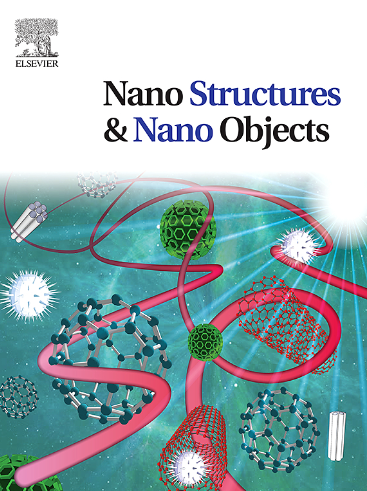Photochemical and electrochemical synthesis of [rGO–AuNps] hybrids dispersions for detection of rhodamine 6G by SERS
IF 5.45
Q1 Physics and Astronomy
引用次数: 0
Abstract
Many hybrid nanomaterials with different types of metallic nanostructures have been studied for diverse applications. Herein, we present four simple experimental strategies, combining photochemical and electrochemical reduction steps to obtain aqueous dispersions of hybrid nanomaterials of reduced graphene oxide flakes (rGO) supporting gold nanoparticles (AuNps). We found clear differences in the optical, structural, and morphological characteristics of the [rGO–AuNps] hybrids due to the size, shape, and distribution of AuNps, according to the synthesis strategy employed. These characteristics are associated with the degree of reduction (C/O ratio composition) and structural defects (Raman intensity ratio between D and G bands) of the rGO formed, both features provide sites available for nucleation and growth of the nanostructures, obtained in each synthesis. The efficiency of different dispersions with plasmonic activity in the detection of rhodamine 6 G (Rh6G) from dilute aqueous solutions was spectroscopically evaluated. SERS (Surface-Enhanced Raman spectroscopy) experiments were performed directly on cellulose fibers (filter paper), previously modified with the assembly of the hybrid nanomaterials, and the Rh6G molecules. In this way, a practical and simple configuration with nanomaterials has been established, as a platform designed for the sensitive detection of adsorbed molecules, potentially useful during the filtration of contaminated water. The SERS spectra of adsorbed Rh6G on the paper membranes with the hybrids [rGO]hυ –[AuNps]hυ and [rGO]hυ–[AuNps]ec for 48 h immersion, showed a 23 ± 5 and 21 ± 5 enhancement factor (EF), respectively.
SERS检测罗丹明6G的[rGO-AuNps]杂化分散体的光化学和电化学合成
许多具有不同类型金属纳米结构的杂化纳米材料得到了广泛的研究和应用。在此,我们提出了四种简单的实验策略,结合光化学和电化学还原步骤,以获得支持金纳米颗粒(AuNps)的还原氧化石墨烯薄片(rGO)混合纳米材料的水分散体。我们发现,根据采用的合成策略,由于AuNps的大小、形状和分布,[rGO-AuNps]杂种的光学、结构和形态特征存在明显差异。这些特征与形成的还原氧化石墨烯的还原程度(C/O比组成)和结构缺陷(D和G波段之间的拉曼强度比)有关,这两个特征都为每种合成中获得的纳米结构的成核和生长提供了可用的位点。用光谱法评价了具有等离子体活性的不同分散体对罗丹明6 G (Rh6G)的检测效率。SERS(表面增强拉曼光谱)实验直接在纤维素纤维(滤纸)上进行,之前用混合纳米材料的组装进行了修饰,以及Rh6G分子。通过这种方式,建立了一个实用而简单的纳米材料结构,作为一个敏感检测吸附分子的平台,在污染水的过滤过程中可能有用。[rGO]hυ - [AuNps]hυ和[rGO]hυ - [AuNps]ec在浸渍48 h的纸膜上吸附的Rh6G的SERS光谱分别显示出23 ± 5和21 ± 5的增强因子(EF)。
本文章由计算机程序翻译,如有差异,请以英文原文为准。
求助全文
约1分钟内获得全文
求助全文
来源期刊

Nano-Structures & Nano-Objects
Physics and Astronomy-Condensed Matter Physics
CiteScore
9.20
自引率
0.00%
发文量
60
审稿时长
22 days
期刊介绍:
Nano-Structures & Nano-Objects is a new journal devoted to all aspects of the synthesis and the properties of this new flourishing domain. The journal is devoted to novel architectures at the nano-level with an emphasis on new synthesis and characterization methods. The journal is focused on the objects rather than on their applications. However, the research for new applications of original nano-structures & nano-objects in various fields such as nano-electronics, energy conversion, catalysis, drug delivery and nano-medicine is also welcome. The scope of Nano-Structures & Nano-Objects involves: -Metal and alloy nanoparticles with complex nanostructures such as shape control, core-shell and dumbells -Oxide nanoparticles and nanostructures, with complex oxide/metal, oxide/surface and oxide /organic interfaces -Inorganic semi-conducting nanoparticles (quantum dots) with an emphasis on new phases, structures, shapes and complexity -Nanostructures involving molecular inorganic species such as nanoparticles of coordination compounds, molecular magnets, spin transition nanoparticles etc. or organic nano-objects, in particular for molecular electronics -Nanostructured materials such as nano-MOFs and nano-zeolites -Hetero-junctions between molecules and nano-objects, between different nano-objects & nanostructures or between nano-objects & nanostructures and surfaces -Methods of characterization specific of the nano size or adapted for the nano size such as X-ray and neutron scattering, light scattering, NMR, Raman, Plasmonics, near field microscopies, various TEM and SEM techniques, magnetic studies, etc .
 求助内容:
求助内容: 应助结果提醒方式:
应助结果提醒方式:


